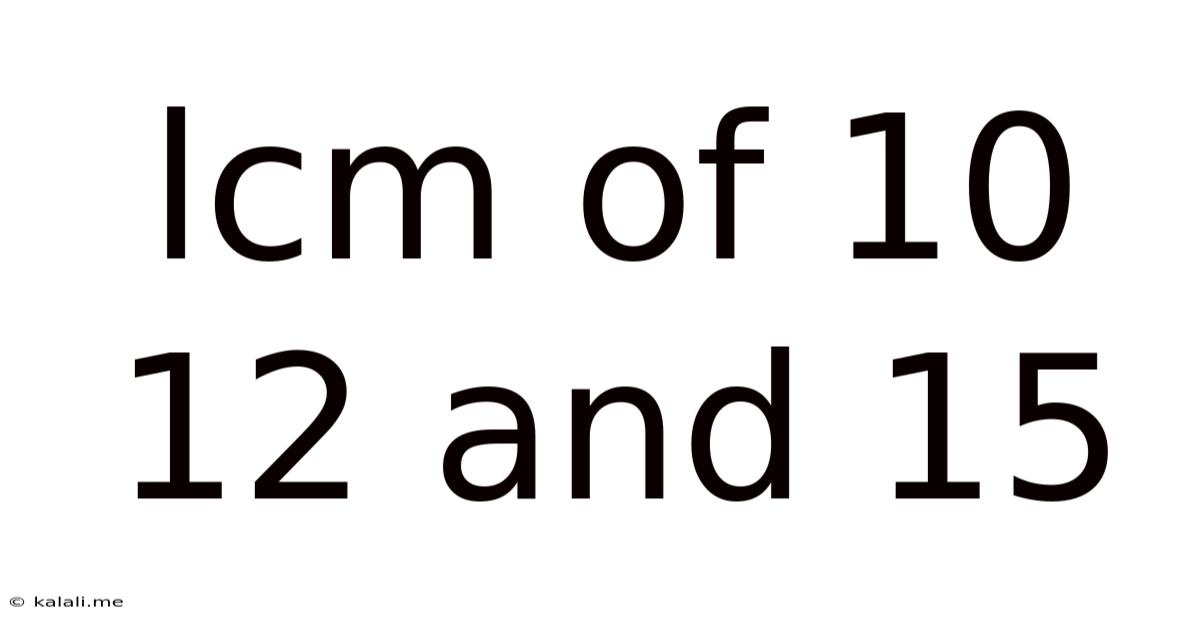Lcm Of 10 12 And 15
Kalali
Jun 11, 2025 · 3 min read

Table of Contents
Finding the LCM of 10, 12, and 15: A Step-by-Step Guide
Finding the least common multiple (LCM) of numbers is a fundamental concept in mathematics, frequently used in various applications, from simplifying fractions to solving problems involving cycles and patterns. This article will guide you through the process of calculating the LCM of 10, 12, and 15 using two common methods: prime factorization and the listing method. We'll also explore the practical applications of LCM and offer tips for solving similar problems efficiently. This will help you understand how to find the LCM of any set of numbers.
Understanding Least Common Multiple (LCM)
The least common multiple (LCM) of two or more integers is the smallest positive integer that is divisible by all the integers. It's the smallest number that contains all the numbers in your set as factors. Understanding LCM is crucial for various mathematical operations and real-world problems.
Method 1: Prime Factorization
This method is generally considered the most efficient for larger numbers. It involves breaking down each number into its prime factors.
-
Find the prime factorization of each number:
- 10 = 2 x 5
- 12 = 2 x 2 x 3 = 2² x 3
- 15 = 3 x 5
-
Identify the highest power of each prime factor:
- The prime factors present are 2, 3, and 5.
- The highest power of 2 is 2² = 4.
- The highest power of 3 is 3¹ = 3.
- The highest power of 5 is 5¹ = 5.
-
Multiply the highest powers together:
- LCM(10, 12, 15) = 2² x 3 x 5 = 4 x 3 x 5 = 60
Therefore, the least common multiple of 10, 12, and 15 is 60.
Method 2: Listing Multiples
This method is simpler for smaller numbers but can become tedious for larger ones.
-
List the multiples of each number:
- Multiples of 10: 10, 20, 30, 40, 50, 60, 70...
- Multiples of 12: 12, 24, 36, 48, 60, 72...
- Multiples of 15: 15, 30, 45, 60, 75...
-
Identify the smallest common multiple:
The smallest number that appears in all three lists is 60.
Therefore, the LCM of 10, 12, and 15 is 60.
Real-World Applications of LCM
The concept of LCM has various real-world applications:
- Scheduling: Imagine three buses arriving at a stop every 10, 12, and 15 minutes respectively. The LCM (60) tells you when all three buses will arrive simultaneously again.
- Fraction Operations: Finding a common denominator when adding or subtracting fractions involves calculating the LCM of the denominators.
- Pattern Recognition: Identifying recurring patterns or cycles often requires determining the LCM of the involved periods.
Tips for Calculating LCM
- Use prime factorization for larger numbers: It's more efficient and less prone to errors.
- Start with the smallest number: When listing multiples, it helps to focus on the multiples of the smallest number first.
- Practice regularly: The more you practice, the faster and more accurately you'll calculate LCMs.
In conclusion, finding the LCM of 10, 12, and 15, whether using prime factorization or the listing method, results in 60. Understanding the process and its applications is vital for various mathematical tasks and real-world scenarios. Remember to choose the method best suited to the numbers you're working with.
Latest Posts
Latest Posts
-
How Many Cubic Feet Are In A 5 Gallon Bucket
Jul 01, 2025
-
1 Lb Of Pasta Is How Many Ounces
Jul 01, 2025
-
How Many Ounces In A Pint Of Blueberries
Jul 01, 2025
-
When Derivatively Classifying Information Where Can You Find A Listing
Jul 01, 2025
-
How Many Hours Is 9am To 1pm
Jul 01, 2025
Related Post
Thank you for visiting our website which covers about Lcm Of 10 12 And 15 . We hope the information provided has been useful to you. Feel free to contact us if you have any questions or need further assistance. See you next time and don't miss to bookmark.